Exceptions In The Dust Collection World: How To Make Your Way Through It All

Dust collection is heavily regulated by laws and regulations to ensure a minimum level of system performance while guaranteeing a safe working environment. These rules are stipulated by various authorities and are often contradictory.
It should be noted that in most cases, large-scale dust collectors must comply with standards and regulations. This involves having to add an array of accessories, the purpose of which is to minimize risks when using the system. It goes without saying that the overall cost for such installations has therefore increased tenfold. For economic reasons, it is easy to see why future buyers are looking to exploit exceptions whenever possible.
To help you see clearly through all these exceptions, we present below the most common exemption rules as well as their interpretation.
Preventing Explosions in a Closed System
It must be remembered that a system is deemed to be closed when the filtering media are confined to the inside of the dust collector. In the presence of potentially explosive dust, it is normally required that this type of device be equipped with a vent to release the pressure generated by an explosion.
In Quebec, according to the CNESST: “All closed collection systems larger than 0.71 m3/s (1500 ft3/min) must be protected by explosion vents or an explosion suppression system that is compliant with NFPA standards 68 or 69. If the collectors are located inside, the explosion vents must lead outside. In such cases, the length of the ducts cannot exceed 6.1 m (20 ft). The structures for the collectors and vent ducts must be reinforced.” [TRANSLATION]
From the Guide Captage et séparation des poussières combustibles (French only)
Therefore, for a closed system with a flow rate of less than 1500 ft3/min, explosion vents are not necessary (accessory #6 on the reference diagram) to act as vents in the event of an explosion. The reason for this is that such a flow rate cannot produce enough pressure in a particle explosion to pierce the steel walls of a dust collector. The system must however be equipped with a blow back damper (accessory #3) to prevent fire from returning.
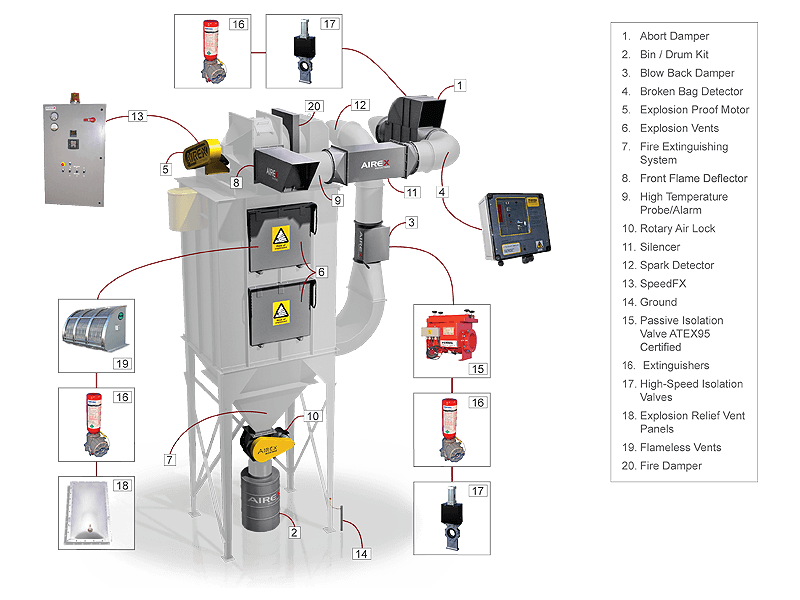
In cases where the filtered air is recirculated, the system must protect the inside of the building in the event of an explosion. If the dust collector is installed on the inside without the possibility of venting to the outside, a high-speed isolation valve (accessory #17) can confine the fire. Otherwise, an abort damper (accessory #1) must be installed to redirect the fire outside.
Furthermore, a spark detection sensor must be connected to the dust collector control panel, which must also be connected to the equipment from which it is collecting particles. This makes it possible to cut off power and prevent more flammable particles from being added to the explosion or fire.
But here there is a contradiction: the standard in the National Fire Code of Canada stipulates that a closed dust collector, installed inside a building, does not require an explosion vent if its capacity is less than 1058 CFM (0.5 m3/s).
Small Open System: Exceptions in the Wood Industry
With an open model (where the filter bags are visible), the maximum authorized flow rate is 0.71 m3/s (1500 ft3/min), except in the wood industry.
Wood dust is not without its hazards, but it is much less hazardous than other types of dust. In this industry, NFPA standard 664 authorizes a flow rate of up to 5000 ft3/min.
Wood industry standard NFPA-664 – 8.2.2.5.1.4 (7): “Open dust collectors are permitted that have a maximum airhandling capacity of 2.4 m3/s (5000 ft3/min) as long as the collector is located at least 6.1 m (20 ft) from any workstation, circulation space, emergency exit or other dust collectors of the same type.”
It should be noted however that sanders cannot be connected to a small open system since this kind of dust is very fine and therefore more hazardous.
What can be done if the minimum distance cannot be respected?
As was seen in the standard above, there must a minimum of 6.1 metres between the open dust collection system and an employee’s workstation, a circulation area or an emergency exit. When the plant configuration does not allow for the system to be placed at such a distance, a screen protecting against explosions must be installed such as:
- A panel, a surface, a separation or an obstacle that will act as a deflector in order to create a safe zone away from spreading flames;
- A steel sheet, synthetic materials or a gypsum wall providing at least 30 minutes of fire resistance.
Such a screen must be installed in a way that protects the surrounding area (you must not be able to see the dust collector). However, the dust collector cannot be completely enclosed otherwise it will be considered a closed system and therefore subject to different rules.
Dust Collection in the Metal Industry
Certain types of dust are much more hazardous than others such as aluminum, magnesium and titanium. When a business has a dry dust collector, the dust collectors must located outside at a good distance from the buildings (15 m). As for wet dust collectors, they can be installed inside since the humidity reduces the risk of fire.
To find out more on the particularities of filtering highly-explosive metal dust, refer to our old publication covering this topic.
Transportation Velocity and Speed
The minimum authorized velocity is normally 3200 ft/min. Anything under this speed there can be problems with dust accumulation in the ducts.
In the metal industry, 3200 ft/min is often not fast enough since the dust is so hazardous that it must be vented out quickly. The NFPA therefore recommends configuring their velocity at 4500 ft/min. However, the belief that a higher transportation speed for metallic particles is advantageous can be misleading since the friction on the walls of the ducts may cause leaks due the abrasiveness of the particles.
Air Recirculation: Possible or Not?
Air recirculation is obviously a logical choice from an energy-efficiency point of view, but it is not always possible to reintroduce filtered air into the building.
According to the recommendations in NFPA (484 - 4.3.6), when a closed dry collector is used to filter aluminum metal dust, the air cannot be recirculated due to the high risk of explosion.
In the case of a wet dust collector, the air is generally sent outside, but under certain specific conditions, it might be permissible to recirculate the air inside.
It should be noted that even in small quantities, certain contaminants cannot be recirculated since they produce proven or suspected carcinogenic effects or they are the source of various diseases. Here are a few examples:
- Crystalline silica from mines or rocks containing granite;
- The smoke from galvanized steel welds since it contains hexavalent chromium;
- Asbestos;
- Petroleum-based products.
Safety First!
As you can see, there are lots of exceptions depending on the industry, types of dust and systems used. Our knowledge of the standards will ensure safety in your facilities, while optimizing the use of your systems. Call on our expertise to discuss your situation!
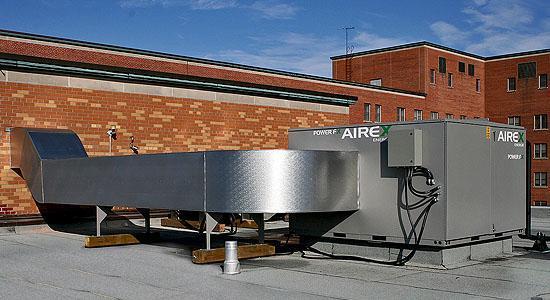
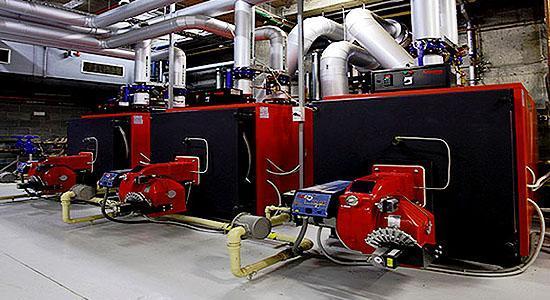
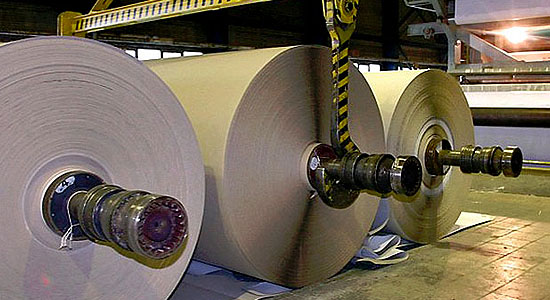
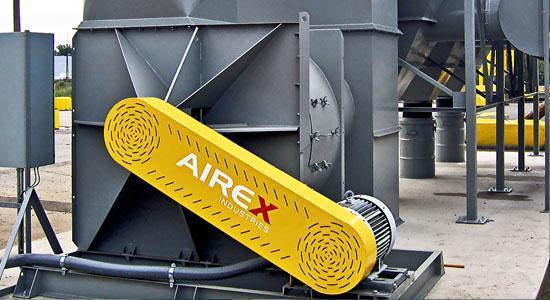
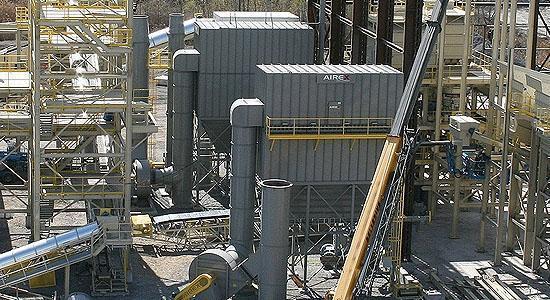

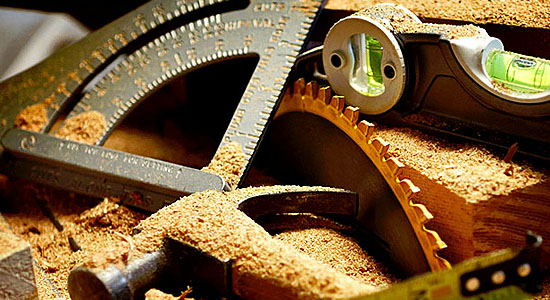
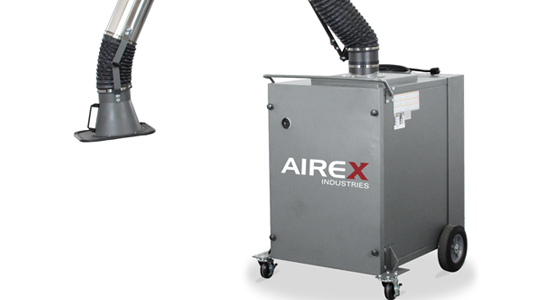
 Not sure what product fits your needs, or you looking for advice about the best solution for your problem?
Not sure what product fits your needs, or you looking for advice about the best solution for your problem?